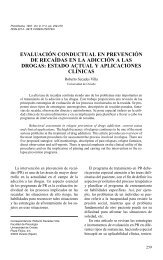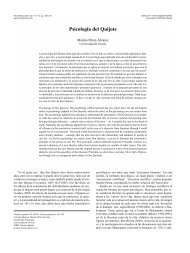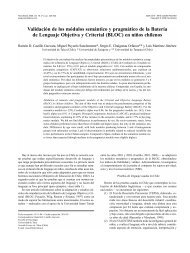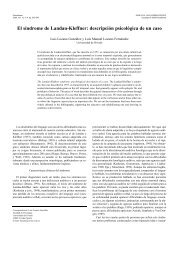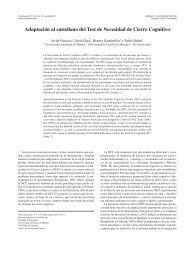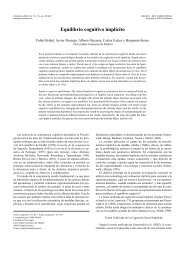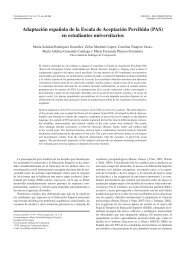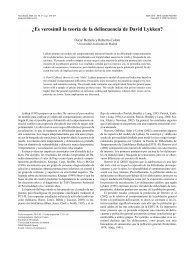Estilo atribucional, autocontrol y asertividad como predictores de la ...
Estilo atribucional, autocontrol y asertividad como predictores de la ...
Estilo atribucional, autocontrol y asertividad como predictores de la ...
Create successful ePaper yourself
Turn your PDF publications into a flip-book with our unique Google optimized e-Paper software.
Psicothema ISSN 0214 - 9915 CODEN PSOTEG<br />
2000. Vol. 12, Supl. nº 2, pp. 331-334 Copyright © 2000 Psicothema<br />
<strong>Estilo</strong> <strong>atribucional</strong>, <strong>autocontrol</strong> y <strong>asertividad</strong> <strong>como</strong> <strong>predictores</strong><br />
<strong>de</strong> <strong>la</strong> severidad <strong>de</strong>l consumo <strong>de</strong> drogas<br />
Francisca López Torrecil<strong>la</strong>s, Ignacio Martín, E. Inmacu<strong>la</strong>da <strong>de</strong> <strong>la</strong> Fuente y Juan F. Godoy<br />
Universidad <strong>de</strong> Granada<br />
Los resultados <strong>de</strong> los estudios que re<strong>la</strong>cionan variables <strong>como</strong><br />
estilo <strong>atribucional</strong>, <strong>autocontrol</strong>, autoeficacia y <strong>asertividad</strong> con el<br />
consumo <strong>de</strong> drogas son todavía poco c<strong>la</strong>ros. En lo que se refiere al<br />
estilo <strong>atribucional</strong> Down, Lawson y Petosa (1986) y Echeburúa y<br />
Elizondo (1988) encuentran que los alcohólicos hacen atribuciones<br />
internas, específicas e inestables <strong>de</strong> sus éxitos, consi<strong>de</strong>rándo<strong>la</strong>s<br />
<strong>como</strong> acontecimientos transitorios. Por su parte, Reich y Gutiérres<br />
(1987) seña<strong>la</strong>n que los drogo<strong>de</strong>pendientes (cocainómanos y<br />
heroinómanos) que hacen atribuciones internas y estables <strong>de</strong> sus<br />
éxitos y tienen mejor pronóstico en su rehabilitación.<br />
Con respecto a <strong>la</strong> <strong>asertividad</strong>, <strong>de</strong> acuerdo con Van Hasselt et al.<br />
(1993), po<strong>de</strong>mos <strong>de</strong>ducir que los individuos que presentan dificulta<strong>de</strong>s<br />
en <strong>la</strong> interacción social y dificulta<strong>de</strong>s para hacer frente a situaciones<br />
difíciles, particu<strong>la</strong>rmente aquel<strong>la</strong>s en <strong>la</strong>s que se ven presionados<br />
para consumir drogas o alcohol, pue<strong>de</strong>n llegar a ser drogo<strong>de</strong>pendientes.<br />
Sin embargo, actualmente <strong>la</strong> evi<strong>de</strong>ncia empírica<br />
en esta área (Rist y Watz, 1983) seña<strong>la</strong> que <strong>la</strong>s diferentes dimensiones<br />
<strong>de</strong> <strong>la</strong> <strong>asertividad</strong> mantienen diferentes implicaciones, específicamente<br />
Van Hasselt et al. (1993) confirman que los sujetos<br />
que inician tratamiento para su drogo<strong>de</strong>pen<strong>de</strong>ncia puntúan mas alto<br />
en espontaneidad y Wills, Baker y Botvin (1989) <strong>de</strong>ducen que<br />
los drogo<strong>de</strong>pendientes que recaen puntúan más alto en <strong>asertividad</strong><br />
que los que no recaen.<br />
Correspon<strong>de</strong>ncia: Francisca López Torrecil<strong>la</strong>s<br />
Facultad <strong>de</strong> Psicología<br />
Universidad <strong>de</strong> Granada<br />
18071 Granada (Spain)<br />
E-mail: fcalopez@p<strong>la</strong>ton.ugr.es<br />
En este estudio se evalúa el tiempo <strong>de</strong> adicción y <strong>la</strong> cantidad <strong>de</strong> droga consumida habitualmente con<br />
d ive rsas sustancias, así <strong>como</strong> el autoinfo rme <strong>de</strong> va ri ables tales <strong>como</strong> <strong>autocontrol</strong>, autoeficacia, asert<br />
ividad y estilo at ri bucional. El objetivo fue <strong>de</strong>scubrir qué va ri ables predicen <strong>la</strong> seve ridad en el consumo<br />
<strong>de</strong> drogas. Se comprobó que, en términos globales, el <strong>autocontrol</strong> y <strong>la</strong> asert ividad predicen tanto<br />
<strong>la</strong> cronicidad <strong>de</strong>l consumo <strong>como</strong> <strong>la</strong> cantidad <strong>de</strong> cocaína y heroína consumidas, el estilo at ri bu c i onal<br />
para los éxitos explica parte <strong>de</strong> <strong>la</strong> va ri abilidad en <strong>la</strong> cronicidad <strong>de</strong>l consumo <strong>de</strong> cocaína, hero í n a<br />
y alcohol, mientras que <strong>la</strong> edad pue<strong>de</strong> intervenir en <strong>la</strong> predicción <strong>de</strong> <strong>la</strong> cronicidad en el consumo <strong>de</strong><br />
h e roína y alcohol.<br />
Attributional sytle, self-control, and assertiveness as predictors of drug abuse. This study examines chronicity<br />
of addiction and quantity of consumption for several substances as well as self-report on variables<br />
such as self-control, self-efficacy, assertiveness and attributional style. The aim was to discover<br />
which variables predict severity in drug abuse. It was found that, in general, self-control and assertiveness<br />
may predict both chronicity and quantity of cocaine and heroin intake, attributional style for<br />
success exp<strong>la</strong>ins to a certain extent the variability in the chronicity of alcohol, cocaine and heroin consumption,<br />
while age seems to have a bearing on predicting chronicity in alcohol and heroin abuse.<br />
En <strong>la</strong> misma línea, Heather (1995), Kahler, Epstein y McCra dy<br />
(1995), Room (1989), y Shiffman y Wills (1985) seña<strong>la</strong>n el pap e l<br />
<strong>de</strong>l <strong>autocontrol</strong> <strong>como</strong> elemento distintivo entre el uso y el abuso <strong>de</strong><br />
<strong>la</strong>s drogas y el alcohol. Santacreu y Frojan (1992) encuentran que<br />
los sujetos que consumen cocaína y heroína presentan niveles <strong>de</strong><br />
a u t o c o n t rol más bajos que aquellos que consumen alcohol y hach í s .<br />
Por último, mencionamos los estudios que re<strong>la</strong>cionan el consumo<br />
<strong>de</strong> drogas con <strong>la</strong> autoeficacia. Cabe esperar que los niveles <strong>de</strong><br />
autoeficacia incidan en todas <strong>la</strong>s etapas <strong>de</strong>l consumo <strong>de</strong> alcohol y<br />
drogas. Bajos niveles <strong>de</strong> autoeficacia coinci<strong>de</strong>n con el inicio <strong>de</strong>l<br />
consumo <strong>de</strong> alcohol y drogas y con <strong>la</strong> recaída (Avant et al., 1995;<br />
Baldwin, Oei y Young, 1993; Bell, Ellickson y Harrinson, 1993;<br />
Has et al., 1995; Litman et al., 1977; Reilly et al., 1995 y Shiffman<br />
y Wills, 1985).<br />
En consonancia con lo anterior el objetivo <strong>de</strong> este estudio es<br />
pre<strong>de</strong>cir <strong>la</strong> severidad <strong>de</strong> <strong>la</strong> conducta adictiva a partir <strong>de</strong> variables<br />
<strong>de</strong> personalidad y <strong>de</strong>mográficas.<br />
Sujetos<br />
Participaron en este estudio 124 sujetos, 39 mujeres y 85 hombres,<br />
con una edad media <strong>de</strong> 26.2 años, <strong>de</strong>sviación típica <strong>de</strong> 4.75<br />
y rango <strong>de</strong> 18-39 años. Los sujetos que componían <strong>la</strong> muestra eran<br />
consumidores <strong>de</strong> alcohol, hachís, cocaína y heroína. Concretamente<br />
el 70.2% consumían alcohol, el 31.5% consumían hachís, el<br />
33.1% consumían cocaína y el 40.3% consumían heroína. Fueron<br />
seleccionados en Centros <strong>de</strong> Drogo<strong>de</strong>pen<strong>de</strong>ncias y en lugares <strong>de</strong><br />
encuentro <strong>de</strong> jóvenes (gimnasios, asociaciones, bares y centros <strong>de</strong><br />
estudios y trabajo) <strong>de</strong> Andalucía y rellenaban <strong>de</strong> forma voluntaria<br />
los cuestionarios, inventarios y esca<strong>la</strong>s que se <strong>de</strong>scriben a conti-
332<br />
nuación. A<strong>de</strong>más se les motivaba entregándoles un informe <strong>de</strong> sus<br />
resultados.<br />
Variables In<strong>de</strong>pendientes:<br />
Medidas<br />
– Cuestionario <strong>de</strong> <strong>Estilo</strong> Atribucional <strong>de</strong> Peterson et al. (1982)<br />
(A.S.Q) Este cuestionario mi<strong>de</strong> <strong>la</strong>s explicaciones dadas por los sujetos<br />
ante acontecimientos <strong>de</strong> éxito y fracaso. (AQS-EX)(AQS-<br />
FRA). El cuestionario consta <strong>de</strong> 12 situaciones, referidas 6 a acontecimientos<br />
<strong>de</strong> éxito y 6 a acontecimientos <strong>de</strong> fracaso. El sujeto<br />
puntúa <strong>de</strong> 1 a 7 <strong>la</strong> causa <strong>de</strong> estos acontecimientos en tres dimensiones:<br />
externa-interna, inestable-estable y específica-global, teniendo<br />
en cuenta que el 1 hace referencia a atribuciones externas,<br />
inestables y específicas y el 7 a atribuciones internas, estables y<br />
globales.<br />
– Inventario <strong>de</strong> Asertividad (AR) <strong>de</strong> Rathus (1973).Esta esca<strong>la</strong><br />
está compuesta por 30 ítems, respecto a los cuáles el sujeto <strong>de</strong>be<br />
indicar el grado <strong>de</strong> acuerdo o <strong>de</strong>sacuerdo, en una esca<strong>la</strong> <strong>de</strong> -3 a 3,<br />
con que cada uno <strong>de</strong> los ítems <strong>de</strong>scribe su propia conducta. Se trata<br />
<strong>de</strong> que el sujeto diga con exactitud si <strong>la</strong> frase propuesta es muy<br />
característica <strong>de</strong> su conducta.<br />
– Cuestionario <strong>de</strong> Autocontrol (AC) <strong>de</strong> Rosenbaum (1980).<br />
Evalúa <strong>la</strong> «competencia aprendida» o habilida<strong>de</strong>s para contro<strong>la</strong>r<br />
los efectos interfirientes <strong>de</strong> los eventos internos (tales <strong>como</strong> emociones<br />
y dolor o pensamientos no <strong>de</strong>seados) que afectan a <strong>la</strong> ejecución<br />
<strong>de</strong> <strong>la</strong> conducta. Consta <strong>de</strong> 36 ítems, respecto a los cuales el<br />
sujeto <strong>de</strong>be indicar el grado en que le <strong>de</strong>scriben o caracterizan, <strong>de</strong><br />
acuerdo con una esca<strong>la</strong> <strong>de</strong> -3 a 3.<br />
– Esca<strong>la</strong> <strong>de</strong> Autoeficacia (A.E) <strong>de</strong> Sherer y Maddux (1982).<br />
Analiza <strong>la</strong>s creencias que tienen los sujetos acerca <strong>de</strong> sus habilida<strong>de</strong>s<br />
para manejar <strong>de</strong>terminadas situaciones. En esta investigación<br />
se utilizó <strong>la</strong> versión traducida y adaptada por Godoy (1990).<br />
Consta <strong>de</strong> 23 ítems, divididos en 2 subesca<strong>la</strong>s. En <strong>la</strong> subesca<strong>la</strong> <strong>de</strong><br />
autoeficacia general, el sujeto <strong>de</strong>scribe cómo maneja <strong>de</strong>terminadas<br />
situaciones re<strong>la</strong>cionadas con tareas personales y en <strong>la</strong> subesca<strong>la</strong> <strong>de</strong><br />
autoeficacia social, el sujeto <strong>de</strong>scribe <strong>como</strong> maneja <strong>de</strong>terminadas<br />
situaciones sociales. En ambas esca<strong>la</strong>s el sujeto <strong>de</strong>be indicar el<br />
grado <strong>de</strong> acuerdo <strong>de</strong> <strong>la</strong> frase que le <strong>de</strong>scribe o caracteriza en una<br />
esca<strong>la</strong> <strong>de</strong> 1 a 5.<br />
– Cuestionario <strong>de</strong> Información acerca <strong>de</strong>l Nivel Cultural y Categoría<br />
Profesional (C.CC.P). Este cuestionario fue <strong>de</strong>sarrol<strong>la</strong>do<br />
para evaluar <strong>la</strong>s variables socio-<strong>de</strong>magráficas. El sujeto tiene que<br />
contestar una serie <strong>de</strong> preguntas tales <strong>como</strong> edad (años), sexo (varón<br />
o mujer), nivel educativo (años <strong>de</strong> esco<strong>la</strong>rización <strong>de</strong> acuerdo a<br />
una esca<strong>la</strong> <strong>de</strong> 1 a 6) y categoría profesional a <strong>la</strong> que pertenece, según<br />
<strong>la</strong> c<strong>la</strong>sificación realizada por el CENSO que incluye una lista<br />
amplia <strong>de</strong> 15 apartados, que se refiere a <strong>la</strong>s profesiones existentes.<br />
En cada uno <strong>de</strong> estos apartados, <strong>de</strong> forma minuciosa aparecen <strong>la</strong>s<br />
profesiones <strong>de</strong>rivadas <strong>de</strong> estudios superiores, tales <strong>como</strong> ingeniería,<br />
matemáticas, hasta <strong>la</strong>s profesiones que sólo requieren experiencia<br />
práctica, tales <strong>como</strong> albañil, pintor, pescador, etc.<br />
Variables <strong>de</strong>pendientes:<br />
FRANCISCA LÓPEZ TORRECILLAS, IGNACIO MARTÍN, E. INMACULADA DE LA FUENTE Y JUAN F. GODOY<br />
– Cuestionario <strong>de</strong> Investigación acerca <strong>de</strong>l Comportamiento<br />
Adictivo (CICA). Este cuestionario fue <strong>de</strong>sarrol<strong>la</strong>do para evaluar<br />
esta investigación, versa sobre el comportamiento adictivo, particu<strong>la</strong>rmente<br />
<strong>de</strong>l consumo <strong>de</strong> alcohol, hachís, cocaína y heroína. Ha-<br />
ce referencia a <strong>la</strong> frecuencia <strong>de</strong> consumo <strong>de</strong> estas sustancias, cantidad<br />
<strong>de</strong> consumo y edad <strong>de</strong> inicio <strong>de</strong> <strong>la</strong>s mismas. Consta <strong>de</strong> 12<br />
ítems que se divi<strong>de</strong>n en tres grupos <strong>de</strong> preguntas. Cada grupo hace<br />
referencia a <strong>la</strong> pauta <strong>de</strong> consumo <strong>de</strong> una <strong>de</strong>terminada droga. Las<br />
drogas <strong>de</strong>notadas por el cuestionario son alcohol, hachís, cocaína<br />
y heroína. Consiste en pedir al sujeto que <strong>de</strong>scriba su historia <strong>de</strong><br />
consumo <strong>de</strong> drogas. Cada una <strong>de</strong> <strong>la</strong>s drogas <strong>de</strong> <strong>la</strong>s que se le <strong>de</strong>manda<br />
información es valorada en función <strong>de</strong> <strong>la</strong> frecuencia <strong>de</strong><br />
consumo, que se puntúa en meses y osci<strong>la</strong> <strong>de</strong>s<strong>de</strong> nunca hasta a diario.<br />
El segundo grupo <strong>de</strong> preguntas hace referencia a <strong>la</strong> cantidad <strong>de</strong><br />
consumo, que se puntúa en unida<strong>de</strong>s al mes, teniendo en cuenta<br />
que un whisky equivale a 1 unidad y un vino o una cerveza equivale<br />
a 0.5, el hachís se puntúa en número <strong>de</strong> cigarrillos y <strong>la</strong> cocaína<br />
y heroína en gramos al mes. El tercer grupo <strong>de</strong> preguntas hace<br />
referencia a <strong>la</strong> cronicidad, se puntúa en años y se valora <strong>la</strong> edad <strong>de</strong><br />
inicio <strong>de</strong>l consumo <strong>de</strong> dichas sustancias.<br />
A partir <strong>de</strong> este cuestionario se obtienen 8 medidas:<br />
1. Cantidad <strong>de</strong> alcohol (Al-can).- Hace referencia a <strong>la</strong> frecuencia<br />
<strong>de</strong> uso y cantidad <strong>de</strong> consumo <strong>de</strong> alcohol durante el último<br />
mes.<br />
2. Cronicidad <strong>de</strong> alcohol (Al-cro).- Se refiere a los años que han<br />
transcurrido <strong>de</strong>s<strong>de</strong> que se inició el consumo <strong>de</strong> alcohol.<br />
3. Cantidad <strong>de</strong> hachís (Hachís-can).- Hace referencia a <strong>la</strong> frecuencia<br />
<strong>de</strong> uso y número <strong>de</strong> cigarrillos fumados durante el último<br />
mes.<br />
4. Cronicidad <strong>de</strong> hachís (Hachís-cro).- Se refiere a los años que<br />
han transcurrido <strong>de</strong>s<strong>de</strong> que se inició el consumo <strong>de</strong> hachís.<br />
5. Cantidad <strong>de</strong> cocaína (Coca-can).- Hace referencia a <strong>la</strong> frecuencia<br />
<strong>de</strong> uso y a los gramos <strong>de</strong> consumidos durante el último<br />
mes.<br />
6. Cronicidad <strong>de</strong> cocaína (Coca-cro).- Se refiere a los años que<br />
han transcurrido <strong>de</strong>s<strong>de</strong> que se inició el consumo <strong>de</strong> cocaína.<br />
7. Cantidad <strong>de</strong> heroína (Hero-can).- Hace referencia a <strong>la</strong> frecuencia<br />
<strong>de</strong> uso y a los gramos <strong>de</strong> consumidos durante el último<br />
mes.<br />
8. Cronicidad <strong>de</strong> heroína (Hero-cro).- Se refiere a los años que<br />
han transcurrido <strong>de</strong>s<strong>de</strong> que se inició el consumo <strong>de</strong> heroína.<br />
Resultados<br />
Se realizó un análisis <strong>de</strong> regresión lineal múltiple para cada una<br />
<strong>de</strong> <strong>la</strong>s variables que componían <strong>la</strong> severidad <strong>de</strong>l consumo, dichas<br />
variables son: alcohol cantidad, alcohol cronicidad, hachís cantidad,<br />
hachís cronicidad, cocaína cantidad, cocaína cronicidad, heroína<br />
cantidad y heroína cronicidad. En los ocho análisis <strong>de</strong> regresión<br />
múltiple <strong>la</strong>s variables in<strong>de</strong>pendientes fueron <strong>la</strong>s mismas variables<br />
<strong>de</strong> personalidad y <strong>de</strong>mográficas (<strong>asertividad</strong>, autoeficacia,<br />
<strong>autocontrol</strong>, estilo <strong>atribucional</strong> para los éxitos, estilo <strong>atribucional</strong><br />
para los fracasos, edad, sexo y nivel educativo).<br />
Los resultados indican que el estilo <strong>atribucional</strong> para los éxitos<br />
y <strong>la</strong> edad predicen <strong>la</strong> cronicidad <strong>de</strong>l alcohol F(8,115)= 4.726;<br />
p
ESTILO ATRIBUCIONAL, AUTOCONTROL Y ASERTIVIDAD COMO PREDICTORES DE LA SEVERIDAD… 333<br />
En <strong>la</strong> tab<strong>la</strong> 1 po<strong>de</strong>mos observar, <strong>la</strong>s variables que predicen <strong>la</strong><br />
severidad <strong>de</strong>l consumo <strong>de</strong> drogas (cantidad y cronicidad <strong>de</strong> alcohol,<br />
cocaína y heroína), los coeficientes estandarizados (divididos<br />
por su error), <strong>la</strong> prueba <strong>de</strong> significación (t) y su correspondiente relevancia<br />
estadística.<br />
Tab<strong>la</strong> 1<br />
Variables que predicen <strong>la</strong> severidad <strong>de</strong>l consumo <strong>de</strong> drogas<br />
VS Ds Vs Predictoras Beta t p<br />
Alco-cro AQS-EX -0.170 -2.007 0.047<br />
EDAD 0.410 4.978 0.000<br />
Coca-cro AC -0.305 -3.306 0.001<br />
AQS-EX 0.217 2.490 0.014<br />
AR 0.320 3.600 0.000<br />
Hero-can AC -0.304 -3.157 0.002<br />
AR 0.229 2.471 0.015<br />
Hero-cro AC -0.279 -2.977 0.004<br />
AQS-EX 0.191 2.161 0.033<br />
AR 0.194 2.152 0.034<br />
EDAD 0.188 2.197 0.030<br />
Discusión y conclusiones<br />
De los resultados obtenidos po<strong>de</strong>mos concluir que el estilo <strong>atribucional</strong><br />
para los éxitos explica una gran parte <strong>de</strong> <strong>la</strong> variabilidad<br />
en <strong>la</strong> cronicidad <strong>de</strong> <strong>la</strong> cocaína, heroína y alcohol. Estos resultados<br />
se hal<strong>la</strong>n en consonancia con los obtenidos por Down et al.,<br />
(1986), Echeburúa y Elizondo (1988) y Reich y Gutierres (1987)<br />
que resaltan <strong>la</strong> influencia <strong>de</strong>l estilo <strong>atribucional</strong> en el consumo <strong>de</strong><br />
Avant, S.F., Margolin, A., Kosten, T.R. y Cooney, N.L. (1995). Differences<br />
between respon<strong>de</strong>rs and nonrespon<strong>de</strong>rs to cocaine cues the <strong>la</strong>boratory.<br />
Addictive Behaviors, 20, 215-224.<br />
Baldwin, A.R., Oei, T.P.S. y Young, R. (1993). To drink or not to drink:<br />
The differential role of alcohol expectancies and drinking refusal selfefficacy<br />
in quartely and frequency of alcohol consumption. Cognitive<br />
Therapy and Research, 17, 511-530.<br />
Bell, R.M., Ellickson, P.L. y Harrinson, E.R. (1993). Do drug prevention<br />
effects persist into high school?. How project alert did with gran<strong>de</strong>rs.<br />
Preventive Medicine, 22, 463-483.<br />
Chaney, E.F., O’Leary, M.R. y Mar<strong>la</strong>tt, G.A. (1978). Skill trainig with alcoholics.<br />
Journal of Consulting and Clinical Psychology, 46, 1.092-<br />
1.104.<br />
Down, E.T., Lawson, G.W. y Petosa, R. (1986). Attributional styles of alcoholics.<br />
The International Journal of the Addictions, 21, 589-593.<br />
Echeburúa, E. y Elizondo, M. (1988). <strong>Estilo</strong> <strong>atribucional</strong> y locus <strong>de</strong> control<br />
en una muestra <strong>de</strong> alcohòlicos anònimos. Revista Vasca <strong>de</strong> Psicología,<br />
1, 71-78.<br />
Has, H., Klepp, K. I., Laberg, J.C y Edward, L. (1995). Predicting adolescents<br />
intentions drink alcohol: Outcome expectancies and self-efficacy.<br />
Journal of Studies on Alcohol, 156, 293-299.<br />
Heather, N.F. (1995). Impaired control: A concept of fundamental significance<br />
reliable?. Addiction, 90, 1046-1147.<br />
Kahler, C.W., Epstein, E.E., McCrady, B.S. (1995). Loss of control and<br />
inability to abstain: The measurement of and the re<strong>la</strong>tionship betweeen<br />
two constructs in male alcoholics. Addiction, 90, 1.025-1.036.<br />
R e fe re n c i a s<br />
alcohol, heroína y cocaína indicando un estilo <strong>atribucional</strong> externo,<br />
inestable y especifico para los éxitos.<br />
E n c o n t ramos también que <strong>la</strong> asert ividad predice tanto <strong>la</strong> cro n i c idad<br />
<strong>de</strong> <strong>la</strong> cocaína y heroína <strong>como</strong> <strong>la</strong> cantidad <strong>de</strong> heroína consumidas.<br />
Los resultados obtenidos se hal<strong>la</strong>n en consonancia con <strong>la</strong> dife re n t e<br />
evi<strong>de</strong>ncia empírica revisada en esta área (Rist y Watzl, 1983; Va n<br />
Hasselt et al., 1993 y Will et al., 1989) que coinci<strong>de</strong>n en resaltar el<br />
p apel <strong>de</strong> <strong>la</strong> asert ividad en el consumo <strong>de</strong> cocaína y heroína. Au n q u e<br />
po<strong>de</strong>mos concluir <strong>de</strong>s<strong>de</strong> nu e s t ros propios resultados y <strong>de</strong> los estudios<br />
revisados que el papel <strong>de</strong> <strong>la</strong> asert ividad es crucial en el campo <strong>de</strong> <strong>la</strong>s<br />
d rogo d epen<strong>de</strong>ncias, <strong>de</strong>notamos que existe todavia controve rsia a <strong>la</strong><br />
h o ra <strong>de</strong> enten<strong>de</strong>r dicha re<strong>la</strong>ción. Esto pue<strong>de</strong> ser <strong>de</strong>bido a <strong>la</strong> propia <strong>de</strong>finición<br />
<strong>de</strong>l término. En <strong>la</strong> <strong>de</strong>finición <strong>de</strong> asert iv i d a d, ap a recen comp<br />
o rtamientos realizados <strong>de</strong> dife rentes maneras y a<strong>de</strong>más <strong>de</strong>p e n d i e ntes<br />
fundamentalmente <strong>de</strong>l contexto y <strong>de</strong>l grado <strong>de</strong> efe c t ividad <strong>de</strong> dicha<br />
conducta, que va a estar en función <strong>de</strong>l logro <strong>de</strong> los objetivos.<br />
Por último, encontramos también que el <strong>autocontrol</strong> predice<br />
tanto <strong>la</strong> cronicidad <strong>de</strong> <strong>la</strong> heroína y cocaína <strong>como</strong> <strong>la</strong> cantidad <strong>de</strong> heroína.<br />
Estos resultados apoyan <strong>la</strong> evi<strong>de</strong>ncia empírica existente en<br />
esta área (Santacreu y Froján, 1992) resaltando que los sujetos que<br />
consumen heroína y cocaína manifiestan una pérdida <strong>de</strong> control.<br />
Un dato l<strong>la</strong>mativo encontrado ha sido que <strong>la</strong> edad <strong>de</strong>l sujeto<br />
pue<strong>de</strong> intervenir en <strong>la</strong> predicción <strong>de</strong> <strong>la</strong> cronicidad <strong>de</strong>l alcohol.<br />
Otras variables in<strong>de</strong>pendientes estudiadas <strong>como</strong> el estilo <strong>atribucional</strong><br />
para los fracasos, <strong>la</strong> autoeficacia, el sexo y el nivel educativo<br />
no contribuyen en ningún caso a pre<strong>de</strong>cir <strong>la</strong> cantidad y cronicidad<br />
<strong>de</strong> <strong>la</strong>s drogas estudiadas.<br />
Nuestros resultados ponen <strong>de</strong> manifiesto el papel <strong>de</strong>l estilo <strong>atribucional</strong>,<br />
<strong>autocontrol</strong> y <strong>asertividad</strong> <strong>como</strong> <strong>predictores</strong> <strong>de</strong> <strong>la</strong> severidad<br />
<strong>de</strong>l consumo <strong>de</strong> drogas y esto nos lleva a p<strong>la</strong>ntearnos <strong>la</strong> necesidad<br />
<strong>de</strong> incluir dichas variables en programas preventivos y <strong>de</strong><br />
tratamiento en el campo <strong>de</strong> <strong>la</strong>s drogo<strong>de</strong>pen<strong>de</strong>ncias.<br />
Litman, G.K., Fiser, J.R., Rawson, N.S.B. y Oppenheim, A.N. (1977). Towards<br />
a typology of re<strong>la</strong>pse: A preliminary report. Drug and Alcohol<br />
Depen<strong>de</strong>nce, 2, 157-162.<br />
Peterson, C., Semmel, A., Von Baeyer, C., Abramson, L.Y., Metalsky, L.I.,<br />
and Seligman, M.E.P. (1982). The attributional style questionnaiere.<br />
Cognitive Therapy and Research, 6, 287-300.<br />
Rathus, S.A. (1973). Esca<strong>la</strong> <strong>de</strong> <strong>asertividad</strong>. En P. Bartolomé, J.A. Carrobles,<br />
M. Costa, T. Del Ser (eds).(1979) (Eds). La práctica <strong>de</strong> <strong>la</strong> terapia<br />
<strong>de</strong> conducta. Madrid: Pablo <strong>de</strong>l Rio (apéndice).<br />
Reich, J.W. y Gutierres, S.E. (1987). Life event and treatment attributions<br />
in drug abuse and rehabilitation. American Journal Drug Alcohol Abu -<br />
se, 13, 73-94.<br />
Reilly, P.M., Sees, K.L., Shopshine, H.S., Hall, S.M, Delucchi, K.L., Tusel,<br />
D.J., Banys, P. C<strong>la</strong>rk, H.W. y Piotrowski, N.A. (1995). Self-efficacy<br />
and illict opioid on a 180-day methadone <strong>de</strong>toxification treatment.<br />
Journal of Consulting and Clinical Psychology, 63, 158-162.<br />
Rist, F. Y Watzl, H. (1983). Self-assessement of re<strong>la</strong>pse risk and assertiveness<br />
in re<strong>la</strong>tion to treatment outcome of female alcoholics. Addictive<br />
Behaviors, 8, 121-127.<br />
Room, R. (1989). Drugs, consciousness and self-control: Popu<strong>la</strong>r and medical<br />
conceptions. Special Issue: Psychiatry and the addictions. In -<br />
ternational Review of Psychiatry, 1, 63-70.<br />
Rosenbaum, M. (1980). Cuestionario <strong>de</strong> <strong>autocontrol</strong>. En A. Capafóns y P.<br />
Barreto (1989) (traducción y adaptación). Competencia aprendida: Fiabilidad<br />
y vali<strong>de</strong>z <strong>de</strong> su medida, críticas y recomendaciones. Revista Es -<br />
paño<strong>la</strong> <strong>de</strong> Terapia <strong>de</strong>l Comportamiento, 1, 19-39.



